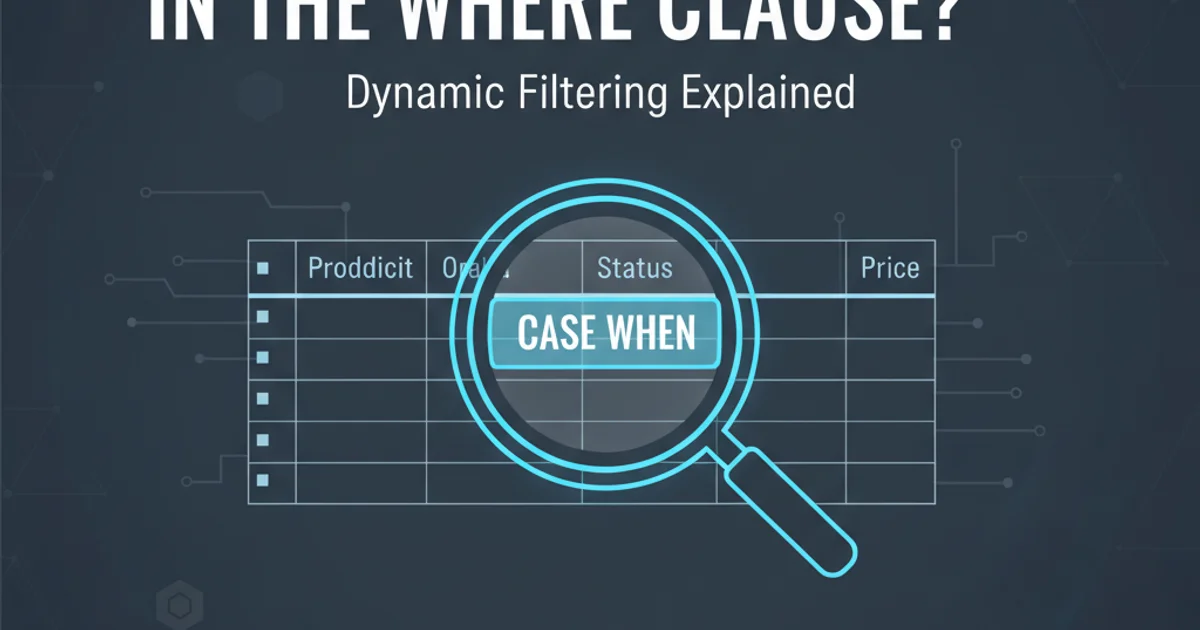using CASE in T-SQL in the where clause?
Categories:
Leveraging CASE Expressions in T-SQL WHERE Clauses for Dynamic Filtering

Explore the power and flexibility of using CASE statements within T-SQL WHERE clauses to implement dynamic and conditional filtering logic in your database queries.
The CASE expression in T-SQL is a powerful construct that allows you to implement conditional logic, similar to if/else statements in other programming languages. While commonly used in SELECT statements to return different values based on conditions, its application within the WHERE clause offers a flexible way to build dynamic filtering criteria. This article will delve into how to effectively use CASE in WHERE clauses, providing practical examples and best practices.
Understanding CASE Expressions in T-SQL
A CASE expression evaluates a list of conditions and returns one of multiple possible result expressions. There are two main forms: simple CASE and searched CASE. In the context of a WHERE clause, the searched CASE expression is typically more useful as it allows for more complex conditions.
Simple CASE:
CASE input_expression
WHEN when_expression THEN result_expression
[ ...n ]
[ ELSE else_result_expression ]
END
Searched CASE:
CASE
WHEN Boolean_expression THEN result_expression
[ ...n ]
[ ELSE else_result_expression ]
END
When used in a WHERE clause, the CASE expression must ultimately evaluate to a boolean value (TRUE or FALSE) that the WHERE clause can use to filter rows. This is often achieved by comparing the result of the CASE expression to a specific value, or by constructing the CASE expression itself to return 1 (TRUE) or 0 (FALSE).
flowchart TD
A[Start Query] --> B{Evaluate WHERE Clause}
B --> C{Contains CASE Expression?}
C -- Yes --> D[Execute CASE Logic]
D --> E{CASE Result TRUE?}
E -- Yes --> F[Include Row]
E -- No --> G[Exclude Row]
C -- No --> H[Evaluate Standard Conditions]
H --> I{Conditions Met?}
I -- Yes --> F
I -- No --> G
F --> J[Continue to Next Row]
G --> J
J --> K[End Query]Flowchart illustrating how a CASE expression is evaluated within a WHERE clause.
Practical Applications in WHERE Clauses
Using CASE in a WHERE clause is particularly effective when you need to apply different filtering logic based on certain parameters or data values. This can simplify complex queries that might otherwise require multiple IF/ELSE blocks in stored procedures, or dynamic SQL generation. Common scenarios include:
- Optional Parameters: Filtering based on a parameter only if it's provided (e.g., not NULL or empty).
- Role-Based Filtering: Showing different data sets to users based on their security roles.
- Date Range Flexibility: Adjusting date filtering logic based on a specific flag.
- Conditional Column Filtering: Applying a filter to one column or another based on a condition.
DECLARE @FilterByRegion VARCHAR(50) = NULL; -- Or 'North', 'South', etc.
DECLARE @MinOrderAmount DECIMAL(10, 2) = 100.00;
SELECT OrderID, CustomerName, Region, OrderAmount
FROM Orders
WHERE
CASE
WHEN @FilterByRegion IS NOT NULL THEN -- If a region is specified
CASE
WHEN Region = @FilterByRegion THEN 1 -- Match the region
ELSE 0
END
ELSE 1 -- If no region is specified, always include
END = 1
AND OrderAmount >= @MinOrderAmount;
Example of using CASE for optional parameter filtering in a WHERE clause.
CASE for optional parameters, a common pattern is (@Parameter IS NULL OR Column = @Parameter). While often effective, CASE can provide more complex conditional logic, especially when multiple parameters interact or different columns need to be evaluated.Performance Considerations and Best Practices
While CASE in WHERE clauses offers great flexibility, it's crucial to be aware of potential performance implications. The SQL Server query optimizer might struggle to create an optimal execution plan when complex CASE logic is involved, especially if it prevents the use of indexes.
Potential Issues:
- Index Usage:
CASEexpressions can sometimes make columns non-sargable, meaning indexes on those columns might not be used effectively. - Complexity: Overly complex
CASEstatements can be harder to read, debug, and maintain.
Best Practices:
- Keep it Simple: If a simpler
ORcondition can achieve the same result, prefer it. - Test Performance: Always test the performance of queries using
CASEinWHEREclauses with realistic data volumes usingEXPLAINorSHOWPLAN. - Consider Alternatives: For very complex scenarios, consider dynamic SQL (with caution against SQL injection), or breaking down the query into multiple parts using
UNION ALLor temporary tables. - Return 1 or 0: When possible, structure your
CASEto return1forTRUEand0forFALSE, then compare theCASEresult to1. This can sometimes be clearer than complex boolean expressions within theCASEitself.
SELECT EmployeeID, EmployeeName, Department, Salary
FROM Employees
WHERE
CASE
WHEN Department = 'Sales' AND Salary < 50000 THEN 1
WHEN Department = 'Marketing' AND Salary < 60000 THEN 1
WHEN Department = 'IT' AND Salary < 70000 THEN 1
ELSE 0
END = 1;
Example of conditional filtering based on department and salary using CASE.
CASE expressions that involve functions on indexed columns within the WHERE clause. This can often lead to index scans instead of more efficient index seeks, significantly impacting query performance.